Subscribe to our newsletter
Embracing Lived Experience: A Data-Driven Look at Autistic Involvement in Autism Research
People with lived experience of a condition bring unique and valuable insights when planning research into that condition. Using data from Dimensions, Emily Alagha examines the evolution of autistic people’s involvement in autism research over the past two decades.
Author’s note about identify-first language
In this post, I am using identity-first language (e.g., ‘autistic person’) to honor the preference of many in the autism community who embrace their identity as an integral part of who they are. This approach reflects the values of empowerment and self-identification.
The Rise of Participatory Research
There’s a growing recognition in the research community that individuals with lived experience of a condition or phenomenon can offer unique and valuable insights to the design of scientific studies. This collaborative approach is often referred to as participatory research and actively involves individuals with lived experience in all stages of the research process. Dimensions data (visualized below) reveals a steady increase in research articles using terms related to participatory research, suggesting a growing embrace of this approach within the scientific community. This shift reflects a move towards more inclusive research practices that empower individuals and communities to actively participate in knowledge creation that is directly relevant to the needs and priorities of those it aims to serve.
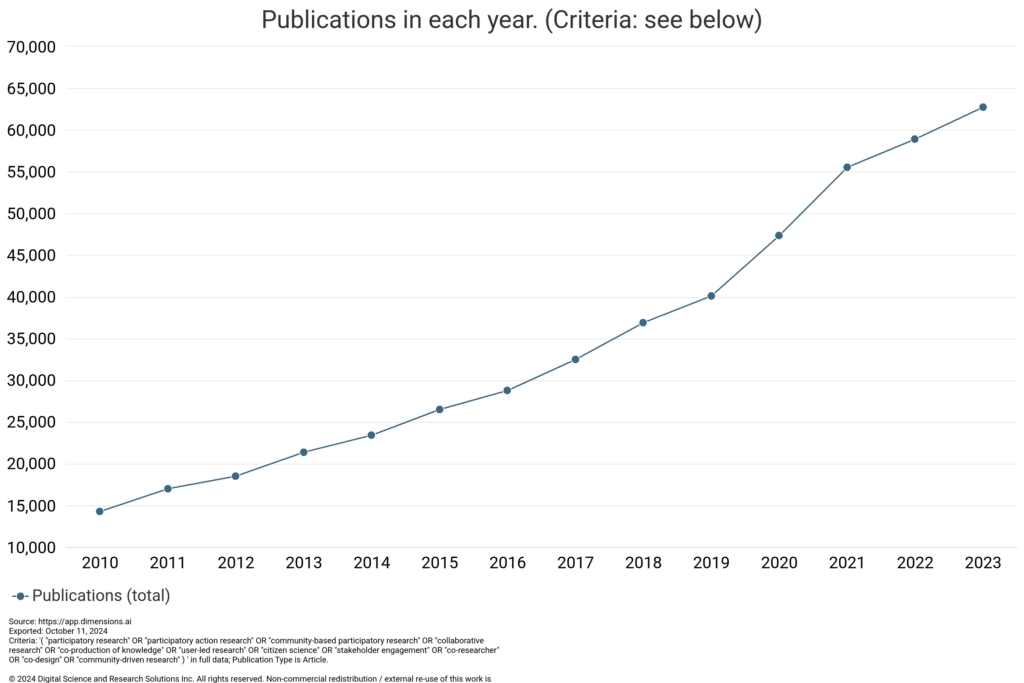
This post examines recent trends in a specific subset of participatory research that highlights lived experience contributions, as identified through publication authorship and acknowledgments. Focusing on autism research, I will delve into this trend by leveraging Dimensions data to analyze autistic authorship and acknowledged collaborative support. I’ll also compare the trajectory of this movement to similar trends in mental health and chronic illness research. Finally, I’ll discuss the implications of these findings for research impact and visibility and advocate for greater inclusion of those with lived experience in shaping future studies.
Characterizing Autistic Contributor Representation in Autism Research Articles
Methodology
Individual contributions to research studies are most often represented by the author and acknowledgements sections of publications. To investigate how autistic contributions are characterized in the literature, I leveraged the capabilities of the Dimensions database to search within the raw affiliation and acknowledgements fields of research publications. I used a combination of search strategies to focus on publications related to autism research and specifically targeted publications that either:
- Included autistic or neurodiverse authors in the raw affiliations section OR
- Acknowledged autistic people, patient networks, or advisory groups in their acknowledgments section AND
- Mentioned autism-related keywords in their full text
I examined author affiliations and acknowledgments to identify the most common language used to represent contributions from autistic people. I also explored bibliometric indicators such as citation counts, Field Citation Ratio (FCR), and Altmetric Attention Scores to assess the impact and reach of autism research with autistic contributors compared to the broader field of autism studies. Finally, I applied the same approaches to explore how lived experience contributions are characterized in other fields to identify avenues for potential future growth of autistic representation in research.
The Rise of Autistic Authorship
To understand how autistic authors represent themselves, I conducted a qualitative review of author affiliations in participatory autism research to identify common phrases and terms. These range from explicit identifiers like “Autistic Researcher” or “Independent Autistic Scholar,” to affiliations with advocacy organizations such as the Autistic Self Advocacy Network, and roles emphasizing lived experience like “Expert by Experience” or “Lived Experience Professional.” While the number of publications authored by self-identified autistic individuals is currently limited (231), these publications offer valuable insights into the unique perspectives and contributions of autistic researchers.
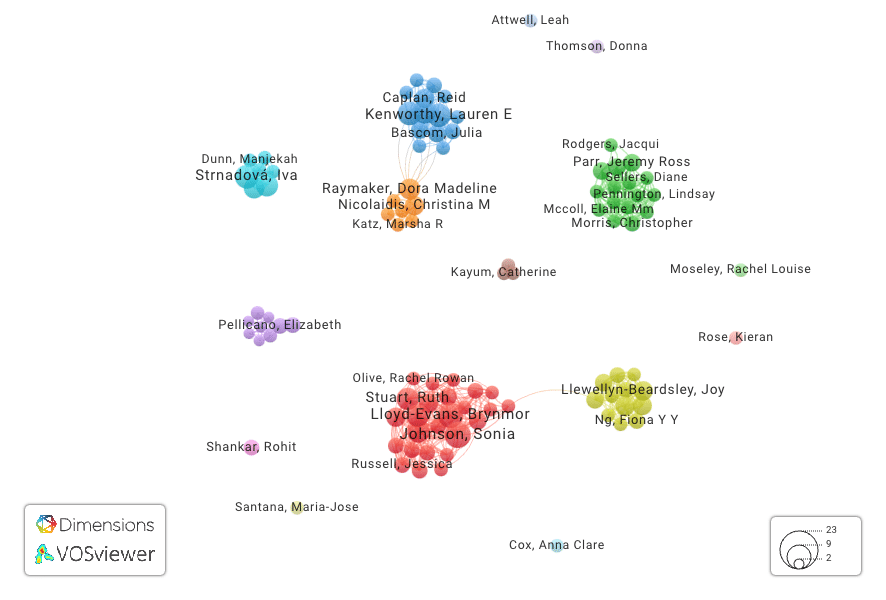
This network visualization represents a preliminary attempt to identify leading neurodivergent researchers engaged in autism and neurodiversity scholarship. While the search terms were designed to highlight self-identified neurodivergent researchers and allies, it’s important to note that this method may not be fully accurate, and not all individuals included may identify as neurodivergent. The visualization highlights key figures like Sonia Johnson, Fiona Ng, and Dora Madeline Raymaker, who are known for their work in this area and could provide valuable leadership on best practices for autistic inclusion in research.
Highlighting specific examples of impactful, autistic-led research with high citation counts and Altmetric Attention Scores (a measure of online attention and engagement) demonstrates the influence of these authors on the broader research conversation.
Top Cited Research Article among Autistic Lived Experience Authors:
- Nicolaidis, C., Raymaker, D., McDonald, K., Dern, S., Boisclair, W. C., Ashkenazy, E. & Baggs, A. (2013). Comparison of Healthcare Experiences in Autistic and Non-Autistic Adults: A Cross-Sectional Online Survey Facilitated by an Academic-Community Partnership. Journal of General Internal Medicine, 28(6), 761–769. https://doi.org/10.1007/s11606-012-2262-7
This study compares the healthcare experiences of autistic and non-autistic adults through an online survey, uncovering significant disparities for autistic people. Autistic collaboration involves authors from the Autistic Self Advocacy Network and the Academic Autistic Spectrum Partnership in Research and Education (AASPIRE). The high citation count of this study underscores its impact on shaping subsequent research around healthcare access and equity for autistic people.
Top Altmetric Score and Field Citation Ratio among Autistic Lived Experience Authors:
- Pearson, A. & Rose, K. (2021). A Conceptual Analysis of Autistic Masking: Understanding the Narrative of Stigma and the Illusion of Choice. Autism in Adulthood, 3(1), 52–60. https://doi.org/10.1089/aut.2020.0043
This conceptual analysis investigates autistic masking as a response to stigma. Collaborators include Kieran Rose of The Autistic Advocate and Infinite Autism. The high Altmetric score and Field Citation Ratio (a measure of a study’s influence within its specific field) highlight the broad reach and impact of this work on online platforms and in further research.
These examples illustrate the power of autistic-led research to generate new insights and draw attention to often overlooked topics. Having examined the influence of key autistic researchers, it’s essential to explore the broader scope of autistic involvement in research, beyond authorship.
Broadening the Scope: How do Papers Characterize Autistic Contributions Beyond Authorship?
While authorship provides a clear indicator of direct contribution, it doesn’t capture the full spectrum of autistic involvement in research. I expanded the analysis to include the acknowledgments section of publications to gain additional insight into how autistic people contribute to and shape research. Acknowledgments often reveal a wider range of roles and contributions, such as participation in advisory boards or community networks.
Expanding the analysis to include publications that acknowledge autistic or neurodiverse people, patient networks, or advisory groups in the acknowledgments section significantly broadened the dataset to 703 publications (as of September 25, 2024). Throughout this post, I use the term ‘autistic-contributor research’ to describe these studies where autistic individuals are explicitly acknowledged or listed as co-authors. This term represents a narrower subset of participatory autism research, specifically focusing on visible contributions through acknowledgments or authorship, rather than all potential forms of participatory involvement.
As the chart below illustrates, this expanded search demonstrates that autistic contributions extend beyond authorship and can be recognized in several different capacities.
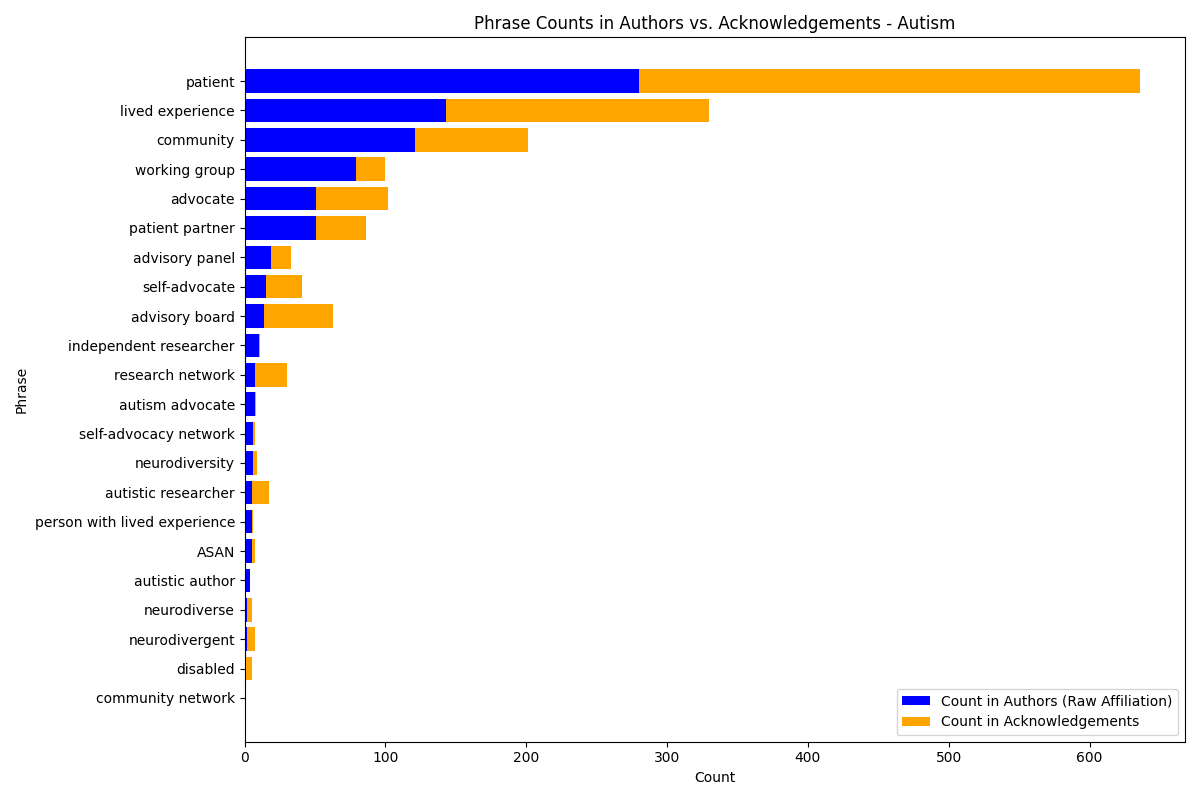
Patient Representation: The term “patient” emerges as a frequent descriptor in research acknowledgments. It can encompass diverse roles like “patient partner,” or refer to administrative functions related to patient involvement. However, the meaning of “patient” in the author affiliation and acknowledgements section can be ambiguous, sometimes signifying autistic individuals themselves, other times denoting individuals with different conditions within the study.
While widely used, “patient” has limitations in autism research. It centers on pathology and potentially overlooks the broader spectrum of autistic experiences beyond the clinical realm. Not all autistic people identify with this label, as it may imply illness or deficit. While “patient” may suggest autistic involvement in healthcare research, it also highlights the need for more precise language that recognizes the multifaceted roles of autistic people beyond the traditional patient-provider dynamic.
Independent Researchers and Advocates: The presence of terms like “advocate,” “self-advocate,” “lived experience,” and “independent researcher” highlights several ways autistic people contribute to research both as individuals and as part of broader groups of expertise. The use of “independent researcher” in affiliations suggests a recognition of the contributions made by autistic researchers working outside traditional academic institutions.
Group Advisory Roles: The prevalence of terms like “advisory board,” “advisory panel,” “community network”, and “working group” underscores the importance of structured mechanisms to ensure that autistic perspectives and lived experiences directly inform research design and implementation. These groups may not always be composed of autistic people, but they often have close ties to communities with lived experience and aim to represent those perspectives.
How do studies integrate autistic voices into the study design? Autistic-contributor research is more likely to use qualitative or mixed-methods approaches
Autistic-contributor studies in this dataset are significantly more likely to employ qualitative or mixed-methods approaches when compared to all autism research. Qualitative methods, such as interviews and focus groups, allow autistic people to express their unique perspectives and insights in their own words. Some examples of how studies may integrate autistic voices include co-creating research questions with autistic people, adapting methods to be more accessible, including autistic researchers on the team, and involving autistic participants in data analysis and communication of findings. These collaborative approaches can help studies be more directly relevant to the autism community.
Who is leading in these types of autistic-contributor collaborations?
It can be useful to explore leading organizations in this dataset to understand where and how investments in autistic-contributor collaborations are happening. Affiliation, funding, and geographic data in Dimensions highlight the United Kingdom’s prominent role in fostering research collaborations involving autistic people. The National Institute for Health and Care Research (NIHR) and the Department of Health and Social Care (DHSC) are the leading funders, while University College London and King’s College London are at the forefront of institutions publishing participatory approaches in this field. These data suggest a strong commitment within the UK to promoting inclusive research practices. However, it’s important to acknowledge that this analysis primarily reflects English-language publications, and there may be additional contributions in other languages that use different terminology to acknowledge autistic participation.
Comparing Autistic-Contributor Autism Research with all Clinical Autism Research
What topics are addressed by autism research that acknowledges autistic partners in the author or acknowledgements fields?
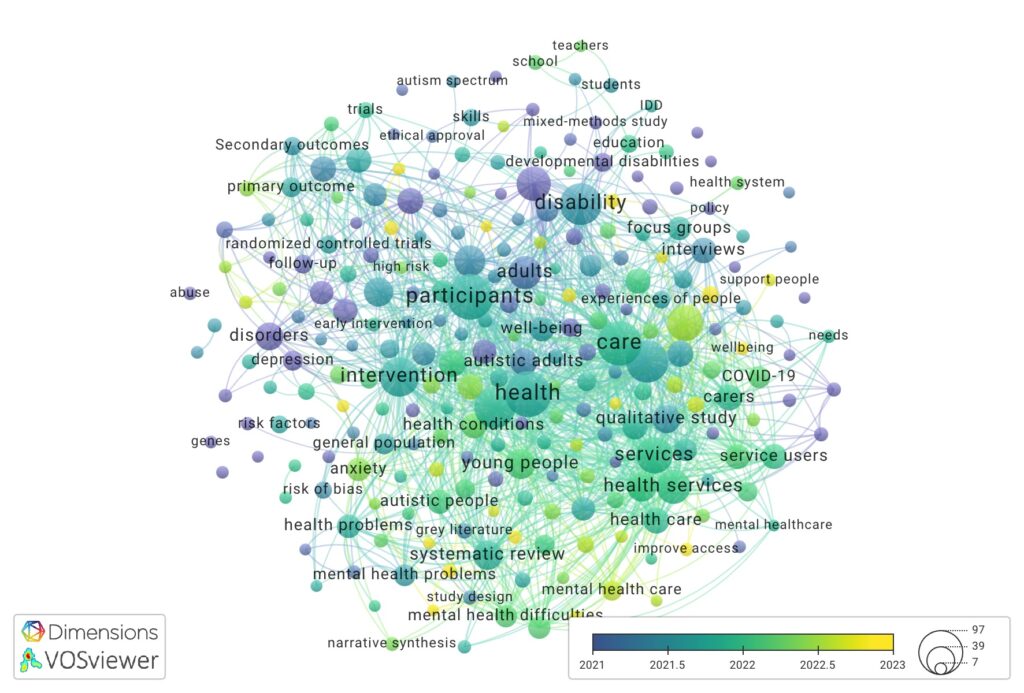
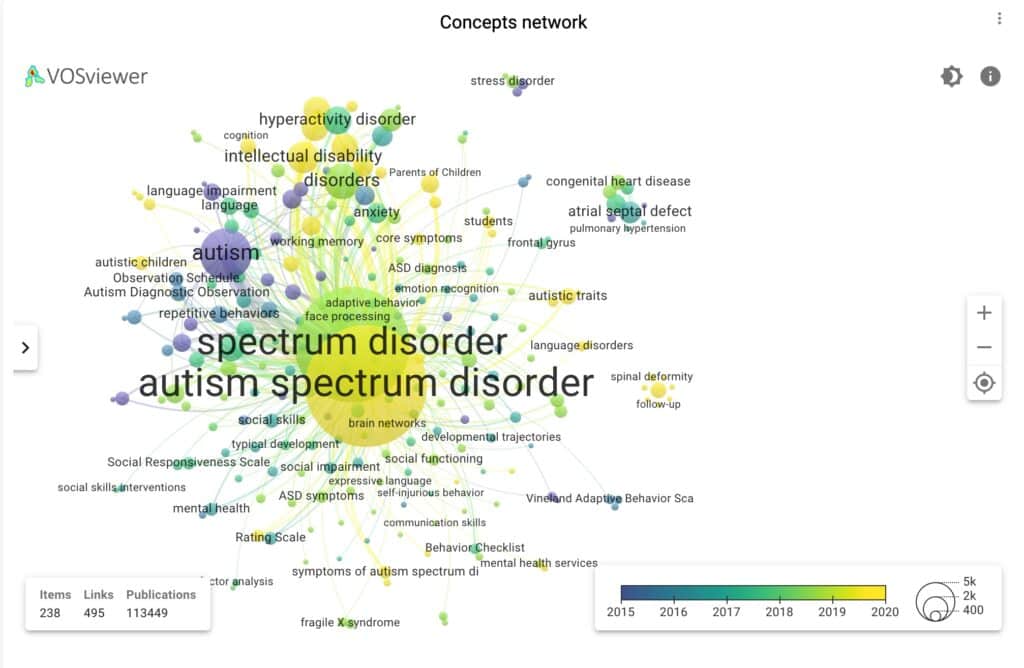
In a concept analysis of autistic-contributor research literature, I found a clear emphasis on lived experience, health services, and support systems. Instead of primarily asking “What causes autism?” or “How can we diagnose autism?”, this research asks “How can we improve the lives of autistic people?”. This emphasis is reflected in the prominence of terms like “improve access” and “health system” in the autistic-contributor research network visualization above.
This focus contrasts with broader clinical autism research, which emphasizes cognitive and behavioral aspects of autism. In the clinical autism concept network above, the strongest themes are diagnosis, social skills, and behavior.
The distinction is further reinforced by how research is categorized. Clinical autism research falls under Field of Research (FoR) classifications of Psychology and Biomedical Sciences, while autistic-led research leans towards Health Sciences and Health Services. This highlights a fundamental difference in priorities.
It’s also worth considering the potential impact of age on these research approaches. Autistic-led research may naturally involve more adults, given the complexities of participating in research design. This could lead to a greater focus on issues relevant to autistic adults, an area often overlooked in traditional research.
How does impact look compared to all autism research?
Data sourced: 25 September 2024.
Though still in its early stages, autistic-contributor research shows promising signs of greater impact in both academic citations and public reach.
Citation, Field Citation Ratio (FCR), & Citation Rate: The average Field Citation Ratio (FCR) for autistic-contributor research is 5.30, compared to 2.31 for all autism research. The citation rate for autistic-contributor autism research (76.65%) is slightly higher than the overall citation rate for autism research (65.57%). Additionally, autistic-contributor research demonstrates a comparable average number of citations per publication (22.76) to the broader field of autism research (23.28). These figures indicate that autistic-contributor research is cited more frequently within the scientific community.
Altmetric Attention Score & Societal Impact: Autistic-contributor research in autism exhibits an average Altmetric Attention Score of 8.6, notably higher than the average of 4 for all autism research. This indicator shows that autistic-contributor autism research sparks more conversations outside of academia than broad autism research.
Translation into Policy, Practice & Innovation: Autistic-contributor research in autism has a higher rate of citation in policy documents (4.7%) compared to the broader field of autism research (2.0%). It also maintains a comparable rate of citation in clinical trials (0.7% vs. 1.2%). However, when it comes to citations in patents, autistic-contributor research lags behind with only 0.4% of publications cited compared to 2.2% in the broader field. These figures suggest that while involving autistic people in research may lead to findings that are more readily translatable into policies and clinical practices, there’s room for growth in terms of fostering innovation and generating patentable discoveries.
Autistic-contributor research in autism represents a small subset of the overall autism literature, but its higher FCR scores and Altmetric Attention Score, comparable citation averages, and stronger translation into policy collectively show the value and influence of research that actively involves autistic people.
Learning from Other Fields: Comparison to Chronic Illness and Mental Health Research Literature with Lived Experience Contributions
Both chronic illness and mental health research fields have a strong track record of including people with lived experience as active contributors. We can gain valuable insights to enhance autistic representation in research by analyzing language used to acknowledge lived experience contributions in these fields. If we were to standardize language used to describe these collaborations, would it be easier to measure these types of collaborations? What terms would be best to use across fields?
“Patient” and “patient advocates” are some of the most highly used terms across both mental health and chronic illness participatory research, but may present challenges in the context of autism research where some participants do not want to pathologize autism. An emphasis on “lived experience” as an authorship and acknowledgement phrase is also common across all three fields, and may be a better approach to recognize contributions in autism research. Another structure sometimes used in the author affiliation fields is “with [condition]”, such as “researcher with chronic illness” or “advisor with bipolar disorder”. This structure is difficult to standardize across research areas and may make it harder to discover experts with relevant lived experience.
Additionally, there is an emphasis on group collaborators across all three fields. The prevalence of working groups and advisory panels demonstrates the effectiveness of these structures in facilitating meaningful participation and ensuring that diverse perspectives are heard.
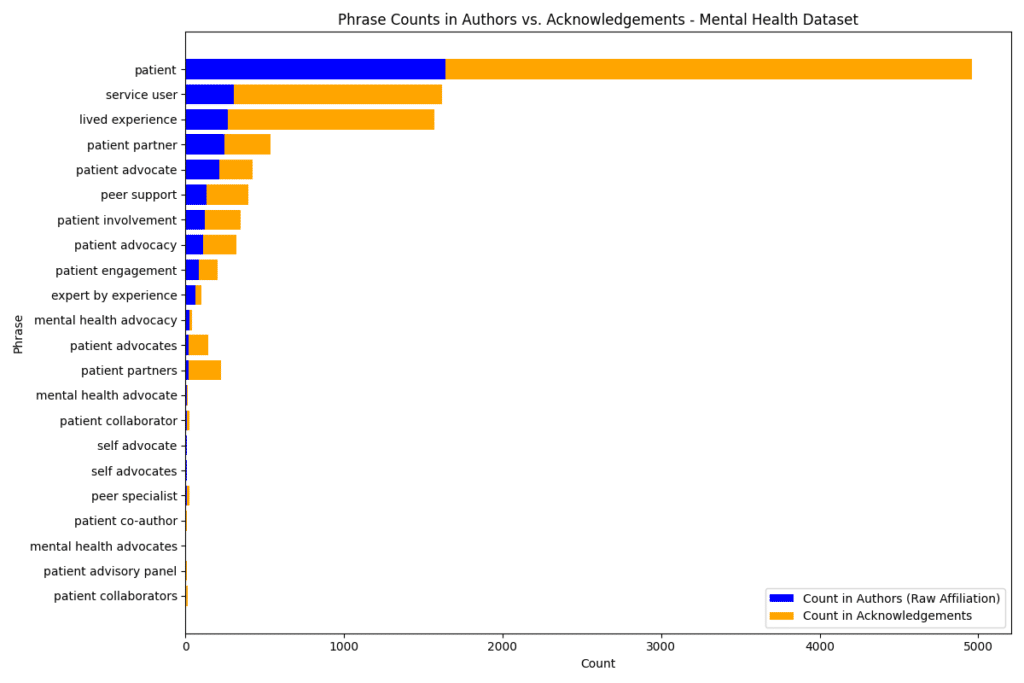
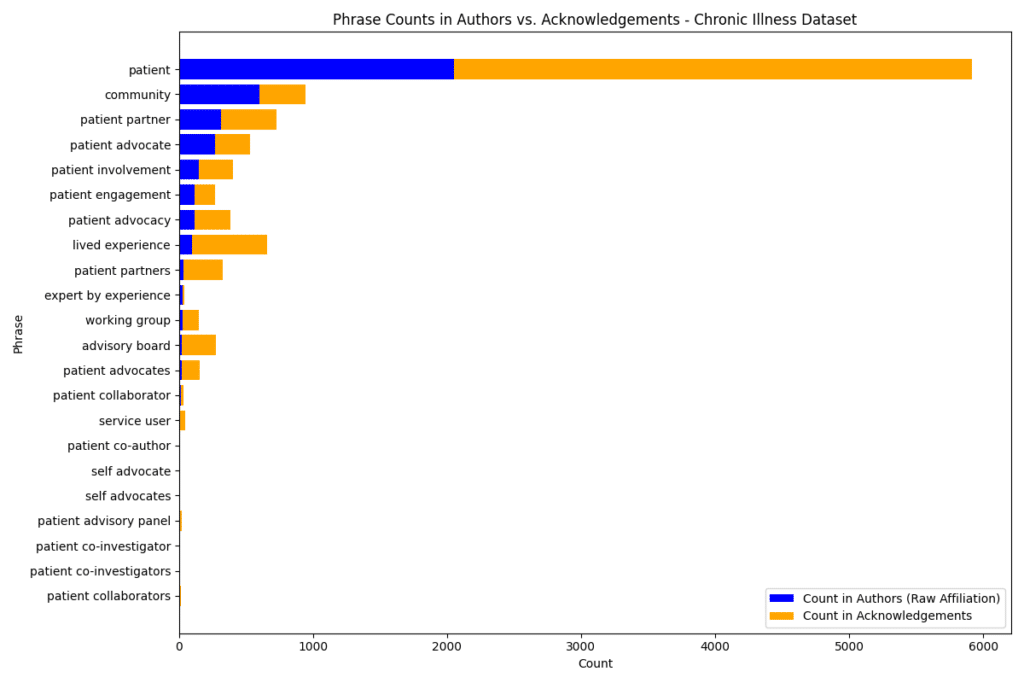
Implications and Recommendations
Despite the promising rise in participatory autism research, it still constitutes a small fraction of the overall autism literature. Much of the research remains rooted in clinical or mechanistic approaches and often overlooks the contributions of those with lived experience. To address this gap, funders, researchers, and institutions must prioritize participatory research approaches that actively incorporate autistic perspectives at every stage of the research process.
Recommendations:
- Funders and Institutions: Prioritize funding and support for participatory research initiatives that actively involve autistic people in all stages of the research process.
- Researchers: Embrace collaborative approaches and methodologies, establish meaningful partnerships with autistic and neurodivergent communities, and ensure that research designs and methodologies are inclusive and accessible.
- Publishers: Consider metadata fields which standardize how participatory collaborations are described, in collaboration with the research community Consistent language can improve the discoverability of lived experience collaborators.
- Autistic Individuals: Seek out opportunities to participate in research, share your expertise and insights, and advocate for greater representation and inclusion within the research community.
By actively involving autistic people in the research process, researchers in the field can improve the relevance of their work and address the real-world challenges and needs of the community. This evidence can inform policy decisions and advocacy efforts that lead to more equitable and supportive systems for autistic people and foster a deeper understanding of autism.
Special thanks to Holly Wolcott, Ph.D., Senior Vice President of Research Analytics at Digital Science, for her insightful feedback on this blog post.
Request a demo or quote

About the Author
Emily Alagha, Senior Director of Research Analytics & Support | Digital Science
Emily Alagha is a Senior Director of Research Analytics & Support at Digital Science, where she leverages AI-powered platforms like Dimensions to support data-driven strategies to optimize research funding and enhance research management practices. With a background in medical librarianship, she is passionate about health literacy and ensuring research is accessible to all. She is also a neurodivergent self-advocate committed to amplifying autistic voices and increasing autistic representation in research.
